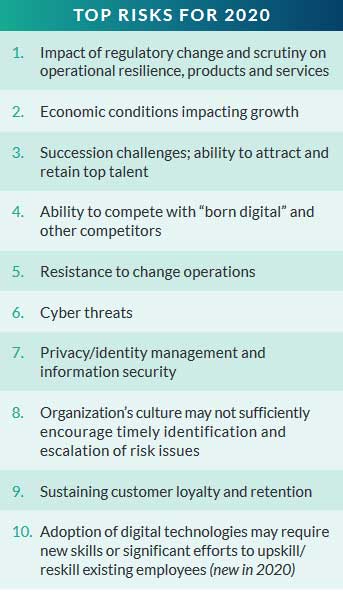
Corporate executives are contending with so many potential risks that, depending on fast-changing economic and market developments, some have to take priority over others. Among those bubbling to the top in Executive Perspectives on Top Risks for 2020, a report from consulting firm Protiviti and North Carolina State University's Enterprise Risk Management Initiative, are: the impact of regulatory change on business; economic conditions that may restrict business growth; and the challenge of recruiting and retaining talent in an environment where business models and processes are being disrupted by technological innovation.
Less top-of-mind among the 30 risk issues in the annual survey are those that pertain to the behavior and personal conduct of management teams; social media or digital applications that may be hurtful to a company brand, reputation or compliance processes; and uncertainties related to geopolitical shifts or the expansion of global terrorism.
The data was gathered in fall 2019, which preceded the escalation in U.S.-Iran tensions and may account for the relatively low geopolitical-risk reading. There were 1,063 board- and executive-level respondents representing multiple business sectors, 39% from North America, 22% from Europe, 18% from Asia, Australia and New Zealand, and 21% from Latin America, Africa, India and the Middle East.
“We structured the survey so that we are able to look at trending risks on a global basis, identified by C-suite and corporate board members, and in such a way that we are able to do an analysis across industry groups from around the world,” said Jim DeLoach, managing director at Protiviti and the study's co-author. The stated time horizon was one year - the outlook for 2020 - and not beyond.

Although risks such as climate change and social unrest may not have risen to the top in this near-term perspective, this does not mean that they are considered unimportant over the long term, DeLoach explained.
By contrast, in the 2020 Global Risk Index from the University of Cambridge Judge Business School Centre for Risk Studies, “interstate conflict” was the second most costly global threat, ranking behind market crash and ahead of tropical windstorm. Social unrest was the fastest-growing threat, though its potential risk value to the major cities included in the Cambridge study, at $8.3 billion, was approximately one-tenth that of interstate conflict.
Geopolitical risks and trade tensions came out on top in another 2020 outlook published in December, Depository Trust & Clearing Corp.'s semi-annual Systemic Risk Barometer. That category was the top risk for 23% of survey respondents. Cyber risk, at 22%, fell to second place for the first time since the barometer was introduced in 2013.
In the World Economic Forum Global Risks Report, released on January 15, international economic confrontations and domestic political polarization were the risks most expected to increase in 2020, each getting a response above 78% from participants in the Global Risks Perception Survey. Extreme heat waves, cyber attacks, and trade and investment protectionism were close behind.
“Advancing Digital Maturity”
“Talent and culture” and “technology and innovation” were the interrelated and overarching themes reflected in the Protiviti-N.C. State findings, Pat Scott, Protiviti executive vice president, Global Industry Program, said in the report's introduction. This comes at a time when companies are striving “to strengthen their competitive position by advancing their digital maturity and embracing the transformative potential of technology.”
DeLoach noted that the 30 risk issues in the survey were divided into three categories: Macroeconomic risks likely to affect growth opportunities; strategic risks that may affect an organization's overall strategy for growth; and operational risks that might affect firms' ability to execute on strategy.
In breaking out individual sector concerns, the survey shows that the top macroeconomic risk on the minds of financial industry executives is economic changes that might restrict growth opportunities.
Peter Henry, W.R. Berkley professor of economics and finance at New York University's Stern School of Business and adviser to Protiviti, said three scenarios of concern are: A major policy mistake by central banks, specifically one that is overly aggressive and triggers inflation; intensification of the global trade war that increases economic uncertainty and lowers the corporate appetite for fixed investment; and a limited, or lack of, recovery in the economies of large emerging markets that puts a damper on the global economy.
“The recovery of emerging markets will be a key factor in 2020,” Henry said.
Also weighing on the minds of financial sector executives are the adoption of digital technologies that may require new skills that are in short supply at a time of record-low unemployment, and an unexpected change in the interest rate environment that may impact operations.
Varying Perceptions
“Companies are concerned about their ability to compete against 'born digital' firms, their ability to employ new technologies to be competitive from a risk perspective, and the risks associated with shifting away from the burden of their legacy technologies,” said Protiviti managing director Kim Bozzella.
The top operational risks for financial executives are organizational succession issues and the challenge of attracting, training and retaining top talent; existing operational challenges, legacy IT infrastructure and insufficient embrace of digital thinking and capabilities; and the resources required for privacy and identity management, appropriate security and information protections.
Different executives' perceptions produce a “decidedly mixed” picture.
For example, chief financial officers and chief audit executives have significantly higher risk expectations compared to 2019, while chief risk officers and CIOs/CTOs have remained fairly consistent. For CEOs, four of the top five risks are macroeconomic. For CFOs, CROs and CAEs, more operational issues are in the top five.
The 216 CROs in the survey are most concerned about regulatory change along with heightened scrutiny; existing operational challenges; resistance to change within their organization that may restrict the necessary shift to digital models and capabilities; succession and talent challenges that could hinder that shift; and inability to utilize data analytics and big data to achieve market intelligence and increase productivity and efficiency.
Need for Consensus
Given disparities between board-member and executive opinions on the most important risks for 2020, the report says, “It is of paramount importance that both the board and the management team engage in risk discussions” to agree on their organizations' most significant risks and goals for risk management.
Financial services executives score high in terms of likelihood to devote time and resources toward risk management in 2020, followed by executives in manufacturing and distribution and energy and utilities.
The largest organizations - those with revenues above $10 billion - exhibit the greatest decline in likelihood to deploy additional resources toward risk management. “This is a somewhat surprising result,” the report says, “given that these organizations are likely to be most exposed to the overall risk environment that is growing in complexity.”
The second tier of organizations, which have revenues between $1 billion and $9.99 billion, show the highest likelihood of committing additional resources to risk management efforts. The smallest organizations exhibited the lowest likelihood.
Less Risk Overall
The ultimate conclusion of the survey is that most respondents rate the business environment for 2020 as less risky than 2019. That is a reversal from a year ago, when the risk level was seen as higher than in 2018.
Nevertheless, Protiviti and N.C. State warn that the ever-changing risk landscape and the overall perceived magnitude and severity of risks should prompt boards and senior executives to closely scrutinize the approaches they use to keep an eye on emerging risks.
“A focus on financial and compliance risks using static analog-age tools without any conception of the organization's risk appetite leaves decision-makers across the company to their own devices,” the report says. Thus it may be time for executives and directors to closely examine how risk management is conducted and pinpoint aspects that require improvement and that might benefit from the use of digital technology.
A concluding thought: “Managing today's risks with outdated technology and tools may leave an organization exposed to significant, undesirable risk events that could threaten its brand, reputation and even its very survival.”
Katherine Heires is a freelance business journalist and founder of MediaKat llc.